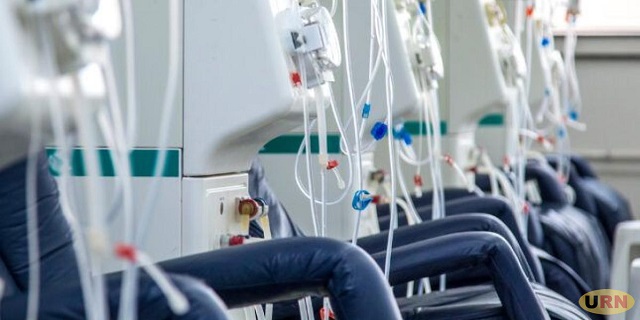
KAMPALA, UGANDA | THE INDEPENDENT | Dr. Emmanuel Ssekasanvu, a top nephrologist or specialist in Kidney care in Uganda. Ask him about Kidney care either at a public or private hospitals, his answer is spot on.
“It is time to perfect our practice. For those things we have been doing badly we should perfect them. Now that we have dialysis, we should do it properly,” Ssekasanvu urged.
Dr. Ssekasanvu, was one of the experts at the just ended 13th Annual Scientific Conference on renal or kidney disease care in Uganda. The conference organized by Uganda Kidney Foundation.
It was part of the efforts to raise awareness about Kidney disease-one of the silent killer diseases in the country. Kidney disease in Uganda is increasing and is among the top 10 causes of death, with a case fatality rate of 21% among patients admitted with Chronic Kidney Disease (CKD).
According to Dr. Robert Kalyesubula, 90% of the people with this disease don’t know that they have it.
“And 70% of the people who have the disease have no symptoms. So if there is a key message here is that for the kidney disease, you have to look for it” advises Dr. Kalyesubula one of the leading renal experts in Uganda. Besides not knowing whether they have the disease, those who know are not on the right treatment.
”Over 52% come to the renal clinic with end stage chronic kidney disease. And we have evidence that kidney disease kills. We looked at fifty thousand individuals. Over four years at Mulago. And kidney disease was the 5th cause of death among those who were dying from Mulago. So we know and we have evidence that kidney disease kills” he said.
Damage leading Kidney disease can be caused by hypertension, obesity, smoking especially in developed economies but in low and medium income countries like Uganda, infections from diseases like malaria, sickle cell, HIV/AIDS, childhood malnutrition can cause chronic kidney disease.
According to Kalyesubula, because of lack of awareness, people present themselves to the care providers at the end stage of the disease.
Kidney patients require dialysis or treatment that cleanses blood and removes excess fluid from your body when your kidneys are no longer healthy enough to perform that function.
Dialysis is normally undertaken three times a week for patients with chronic disease. It has emerged that some hospitals like Mbarara Regional Referral and Kiruddu in Kampala have offered less than required dialysis services and therefore risking the lives of the patients. And that because of the inadequacies, some protocols of care have not been adhered to leading to unwanted infections during dialysis. Costs remain the significant barrier for many patients.
Dialysis in Uganda is mostly paid as an out-of-pocket cost of the patients or their family members. Each session of dialysis at public hospitals costs between 70,000 to 150,000 shillings, while private hospitals charge between 350,000 to 550,000 shillings per dialysis session.
The conference was held at the time when a team of experts from Kiruddu hospital was planning to set up a satellite dialysis site at Hoima regional Hospital.
There should be dialysis services at, Mbrarara, Lira and Mbale Regional Referral hospitals. Dr. Ssekasanvu attentively listens to some his former students now emerging experts in internal medicine as they make presentations at the conference.
One of the presenters is Dr. Oriba Dan Langoya, a Physician and the Head of Department of Internal Medicine at St Mary’s Hospital.
Patients with chronic kidney disease in Gulu have to travel for over 350 kilometers to access dialysis services in Kampala. In absence of dialysis services in at Gulu regional referral hospital and Lacor Hospital, Dr Oriba has used peritoneal dialysis to treat acute kidney injury in patients as an alternative to machine dialysis.
Peritoneal dialysis is a treatment for kidney failure that uses the lining of one’s abdomen, or belly, to filter your blood inside their body.
Oriba remembers how he saved a teenage patient who was almost let to die because medics suspected that he was suffering from Ebola. “Peritoneal dialysis remains very effective and safe dialysis modality with patients with Acute Kidney Injury” says Oriba.
“You find that peritoneal dialysis is associated with a shorter time to recovery compared to hemodialysis” he said.
Dr. Caroline Awujo, a Pediatric Nephrology expert at Mulago National Referral Hospital has also tried out peritoneal dialysis.
She has since 2019 tried out this type of dialysis with improvised supplies. “You can do peritoneal dialysis with improvised supplies. You make up your fluids. And there are now recognized guidelines for that” says Awujo.
Awujo’s reveals that her approach has been to manage the patients through peritoneal dialysis while training nurses and others to administer this rather less costly type of dialysis. Nurses cut corners to work with what is available
Dr. Adolph Byamukama from Mbarara Regional referral hospital made a presentation based on a study about adequacy of hemodialysis at the Mbrarara site. Mbarara Regional Referral hospital currently only provides hemodialysis for acute and chronic kidney disease.
“This is a treatment that most of our patients pay for. And so at the end of the day, while it is recommended that patients should go through three sessions per week, most of our patients can afford only two sessions per week” said Byamukama.
So in Mbrarara, the patients go through eight hours instead of 12 hours of dialysis per week.
“At the end of the end of the day, we think patients don’t get adequate dialysis. We know that when a patient gets adequate dialysis, the adequacy of dialysis improves the quality of life. And also at the end of the day mobility and mortality reduces” said Byamukama.
Byamukama is aware of the danger of not administering a full dose of dialysis. However, he can only offer that to patients who can affords three sessions of dialysis.
“We know for sure that if you have a patient who is having adequate dialysis. For every 5% increase urea reduction ratio, you have get reduction in mortality of up to 11% and this has been documented” he said.
Professor Robert Kalyesubula is irked by the revelations from Mbarara Regional Referral Hospital. “The standard of dialysis can never be two times a week. And I’m happy that the nurses are here. Dr. Bagasha did a study from Kiruddu. He found that if you do dialysis once or twice a week, and other people don’t do dialysis, the results are the same” said Kalyesubula.
“The key message here is that we can reverse those problems. You can do a lot to reverse the kidney problem. It is like giving anti-malarial treatment. They are given for three days. Dialysis is the same we do it three times a week,” says Professor Kalyesubula.
Kalyesubula said the quality of life in the people who dialysis is worse than those who don’t.
“I know that we have inadequacies but let’s not normalize abnormalities. We can look at how to implement but when you say the standard of care is two times, that is very worrying because it is not a standard” Kalyesubula counseled.
Dr. Emmanuel Ssekasanvu who has been silent all along, clears his voice and then he suggests that he should take some of the presenters to court for “malpractice” .
“These should include Dr. Oriba Dan Langoya, Dr. Batte and Dr. Carol Awujo. I was debating of who of the three I should take to court. And in my mind, I thought I should leave Oriba. And take Dr. Carol and Batte to Court. The question I have for them is what is the standard modality of renal replacement or dialysis acute and chronic kidney disease for children in Mulago hospital? Ssekasanvu asked.
He is of the view that Mulago National Referral which should be offer the highest standards in medical training should not be engaged cutting corners.
“It should be our star unit. It is not nice if you have deficiencies and you have to improvise all the time. That means failure on your part to impress the administration and the people who are giving resources to these units to actually give you something basic or something standard to show the Oribas(Private Hospitals) so they can modify their standards” said Dr. Ssekasanvu.
“The presentations that you have given us should actually be given to the administrators of the hospitals so that they can look into themselves or the ministry of health. We need to stamp our foot and tell them what we need. We have seen them waste resources in things that we don’t need” Ssekasanvu added.
To a lay person, Dr Caroline Awuja and Dan Oriba Langoya deserve praise for coming up with less-costly peritoneal dialysis.
Dr. Grace Kansiime, of Mbarara University of Science and Technology (MUST) conducted research around patients who had died despite being initiated on dialysis. She discovered that those on dialysis had cardiovascular diseases.
Professor Kalyesubula agreed that what kills the patients at dialysis units is not the kidney but cardiovascular risks, infections and the kidney ranking third. It has been documented that diabetes for example increases death of those with kidney disease.
“In fact, kidney failure is a greater risk than smoking, it is a greater risk than even diabetes. Once you end into kidney failure, your risk of cardiovascular death totally goes up. Of course you have to bear in mind that it is hypertension and diabetes could have caused the kidney disease in the first place”
Water quality and renal services
Studies have found that the quality of water and associated dialysis solutions can have adverse patient outcomes. It is a concern to Dr. Ssekasanvu too. He agrees that heavy metal contaminants in water definitely affects dialysis services.
“We have had issues with water quality. Because the water quality in Kampala and elsewhere is very variable. Even in one day you can have water vary many as ten or twelve times” says Ssekasanvu.
“Because people dig, break pipes, sewerage goes into the pipes. So actually getting proper water quality in Kampala is a night mare” he added.
Dr. Ssekasanvu says while there have been efforts to install water filtration which have to be changed over given time frames, dialysis technicians may get tempted to bypass the processes or not to change the filters as required because of resource constraints.
“Somebody here was saying if the patients come, you cannot tell them that the water quality is bad. So they bypass some of the filters so that the machines can run that is very dangerous. We should always make sure that water goes through all the stages of filtration so that we get ultra-pure water for dialysis” he cautioned.
Ssekasanvu suggested that it is time that public and private renal care providers stepped up the quality of services having emerged from what he described as baby steps of care.
”The baby steps are not smooth. You keep on having falls here, staggering there. And I think it is time to perfect our practice. Those things we have been doing badly we should perfect them. Now we have dialysis, we should do it properly.”
*****
URN
 The Independent Uganda: You get the Truth we Pay the Price
The Independent Uganda: You get the Truth we Pay the Price



